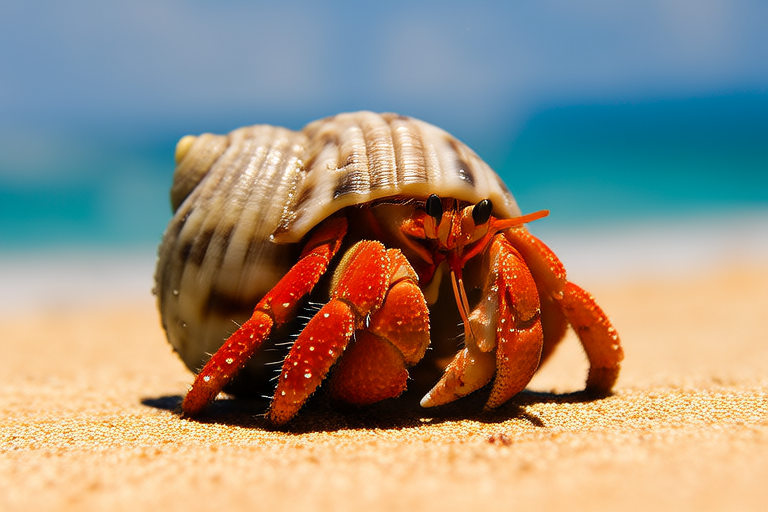Shell Swap Shenanigans: Understanding the Playful Side of Hermit Crabs
Hermit crabs are among the most fascinating creatures in the ocean, known for their unique lifestyle of living in borrowed shells. This article delves into the natural behavior of hermit crabs, particularly focusing on their shell-swapping antics. We will explore why they change shells, the playful dynamics involved, and how you can create a suitable environment for them if you’re a pet owner.
The Natural Habitat of Hermit Crabs
Hermit crabs inhabit a wide range of marine environments, from tropical coral reefs to sandy beaches. They are most commonly found in coastal areas where there is an abundance of gastropod shells, their preferred housing. These crustaceans have adapted to live in these borrowed shells, which protect their soft abdomens. The shells also play a crucial role in their survival, providing shelter from predators and harsh weather conditions.
One interesting fact is that hermit crabs can be quite particular about their homes. Studies have shown that they prefer shells that match the color and texture of their native habitat. For instance, hermit crabs found in coral-rich environments often choose shells with intricate patterns that blend seamlessly with their surroundings. This preference highlights the intelligence of these creatures and their ability to adapt to their environment.
Motivations Behind Shell Swapping
Hermit crabs swap shells for several reasons, including growth, damage to their current home, or simply finding a more comfortable fit. As hermit crabs grow, they outgrow their shells, making it necessary to find larger ones. This growth cycle is a significant factor in their frequent shell changes. Additionally, if a hermit crab’s current shell becomes damaged or cracked, it poses a risk to the crab’s safety, prompting a search for a new, sturdy home.
However, shell swapping isn’t just about necessity; it’s also a social activity. Hermit crabs often gather in groups to exchange shells, creating a lively and dynamic scene. During these events, hermit crabs display remarkable patience and coordination. One crab may vacate its shell, and another will quickly move in, sometimes triggering a chain reaction as other crabs take advantage of the opportunity to upgrade their accommodations.
Playful Dynamics During Shell Exchanges
The process of shell swapping among hermit crabs is not only functional but also playful. Observers have noted that hermit crabs seem to engage in a sort of game when exchanging shells. They often inspect potential new homes carefully, sometimes even trying them on like hats before making a final decision. This behavior suggests a level of thoughtfulness and consideration, as well as a sense of fun in the selection process.
There are instances where hermit crabs have been observed competing for the same shell, leading to what appears to be a playful tug-of-war. In such situations, the smaller crab usually retreats, recognizing the futility of its efforts against a larger opponent. This demonstrates the social hierarchy within hermit crab communities and the respect they show towards each other.
Studies Highlighting Hermit Crab Intelligence
Several studies have explored the cognitive abilities of hermit crabs, revealing surprising insights into their decision-making processes. One study found that hermit crabs are capable of assessing the suitability of a shell based on its size, weight, and structural integrity. They can even remember previous encounters with certain shells, indicating a form of memory retention.
Anecdotes from researchers and hobbyists alike suggest that hermit crabs exhibit problem-solving skills. For example, some crabs have been observed stacking smaller shells on top of larger ones to create makeshift shelters, demonstrating creativity and resourcefulness. These behaviors highlight the adaptability of hermit crabs and their ability to thrive in diverse environments.
Tips for Creating Suitable Environments
If you’re considering keeping hermit crabs as pets, it’s essential to provide them with an environment that mimics their natural habitat as closely as possible. A spacious tank with a mix of sand, rocks, and driftwood can serve as a stimulating and safe space for your crabs. It’s also important to offer a variety of shells in different sizes and shapes to accommodate their growth and preferences.
Hermit crabs are social animals, so it’s beneficial to keep them in groups. However, ensure that there are enough shells for all the crabs to avoid conflicts. Regularly check the condition of the shells and replace any that become damaged or worn. Additionally, maintain a consistent temperature and humidity level in the tank, as hermit crabs are sensitive to environmental changes.
Enriching Your Hermit Crabs’ Lives
To enhance the quality of life for your hermit crabs, consider adding enrichment items to their habitat. These could include small toys, tunnels, or hiding spots made from natural materials like seashells or driftwood. Providing a variety of textures and structures encourages exploration and physical activity, which are vital for their overall health and well-being.
Another way to enrich your hermit crabs’ lives is by introducing new elements to their environment periodically. This could involve rearranging the layout of the tank or adding new objects for them to investigate. By doing so, you stimulate their curiosity and provide opportunities for learning and adaptation.
Conclusion
Hermit crabs are delightful creatures with a playful side that comes alive during shell-swapping activities. Their natural behavior, driven by both necessity and social interaction, showcases their intelligence and adaptability. Whether you’re a casual observer or a dedicated hermit crab enthusiast, understanding the motivations behind their shell swaps adds a layer of appreciation for these fascinating crustaceans.
For those fortunate enough to have hermit crabs as pets, creating a suitable environment that supports their needs is paramount. By offering a variety of shells, maintaining optimal conditions, and enriching their habitat, you can ensure that your hermit crabs lead happy and healthy lives. Embrace the whimsical nature of these creatures and enjoy watching them navigate their ever-changing world with grace and charm.
